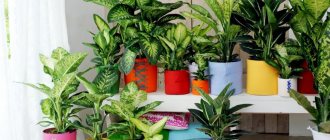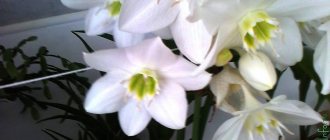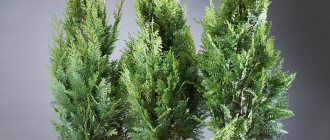Dieffenbachia is an evergreen plant with inconspicuous flowers, which are extremely rare at home. Breeders are attracted to the leaves, which are full of bright colors all year round. The juice is poisonous and has astringent properties, causing laryngeal swelling in concentrated form. It is believed that the presence of this plant in the bedroom weakens male power.
Positive properties include the ability to absorb negative energy. It is better to place the flower in the living room or kitchen, where quarrels occur more often. The released substances cleanse the air of toxins: xylene, formaldehyde, benzene and trichlorethylene. For apartments and houses located near roads, this is an indispensable assistant.
Proper care will allow Dieffenbachia to show its best side, extinguishing negative outbursts and creating an atmosphere of harmony in the family.
Dieffenbachia flower: home care
This plant is recommended for beginners as it is easy to care for. It is important to consider that the ground part of Dieffenbachia grows up to 2 m or more. Over time, you will need support and care will become more difficult.
Lighting
The plant vitally needs bright light. But the directed rays of the sun burn large leaves. The best place would be the northwest or east side. Dieffenbachia will have to be protected from the intense light of southern windows with tulle or fabric blinds. Provided that an adult does not fit on the windowsill and stands on the floor, this is quite acceptable.
Placing a tree in a darkened corridor or in the back of a room is strictly contraindicated: the leaves shrink, lose their brightness of color, and the stem becomes deformed, trying to be attracted to the nearest light source.
The first signal of a lack of light is the disappearance of spots on variegated varieties. In summer it will be useful to take Dieffenbachia out to the balcony or loggia.
Watering
The roots of this evergreen tree are contraindicated in constantly damp soil - they have a tendency to rot. Between moistening procedures, the soil should dry out at least a third of the container, which can be easily checked with a regular wooden skewer.
This is especially true if the pot does not have a drainage system and the soil mixture has a dense structure with low porosity. Watering is carried out with soft water at room temperature in the first half of the day.
Air humidity
A guest from the tropics needs high humidity. Maintaining a level of 60% in the room is problematic, and this is difficult for the owner to bear. Therefore, you will have to spray the leaves daily with settled water from a spray bottle.
The plant suffers the most damage in winter, standing on the floor next to the radiator, the heat which burns out the moisture in the air. But if the temperature in the room does not rise above +18°C, there is no need to carry out additional manipulations. It is enough to wipe the sheet plates with a damp, clean sponge every 2-3 days, while simultaneously cleaning them from dust.
Optimal temperature
Proper care of this plant requires the absence of drafts and the presence of warm air. In hot weather, the thermometer should read from +20°C to +26°C, and in winter - from +15°C to +18°C. When the mercury drops below +10°C, the plant withers and dies.
What kind of soil does he like?
Due to its tendency to rot, the root system of Dieffenbachia needs loose soil that will “breathe,” allowing the plant to dry out before the next watering. Planting in dense soil threatens the tree's death.
The following composition is best suited: universal peat soil - 70%, and the rest is baking powder. The latter includes sand, vermiculite, crushed bark and perlite.
It is irrational to immediately plant a plant in a large pot, with the assumption that it will grow big anyway. While the bush is compact, it needs a small amount of moisture and will rot in a large container, and the earthen lump will take a long time to dry out.
Therefore, growing Dieffenbachia is accompanied by frequent transplants, during which it is recommended to add crushed charcoal or activated carbon to the soil mixture to reduce the risk of plant death due to rot.
How to fertilize
The growing season for this species lasts from April to August. A deficiency of nutrients during this period is fraught with yellow leaves, their accelerated fall in the lower part of the trunk and a decrease in the size of the plates.
Dieffenbachia, which loves both organic and mineral mixtures as fertilizer, will be delighted with additives rich in nitrogen. Feeding is carried out 2 times a week.
In winter, growth slows down and hibernation is possible. From September to March, the frequency of fertilizing is reduced to once a month.
Bloom
Dieffenbachia, with careful care and comfortable conditions, is capable of blooming, because it is not for nothing that it belongs to the aroid family. The buds are shaped like calla lilies and spathiphyllums: a long ear, surrounded by a light green or beige blanket, with a massive thick core.
This phenomenon is characterized by growth retardation, since all forces are spent on the release of peduncles. The lower part may become very exposed.
At home, this is very rare and most owners have never witnessed this miracle. All that remains is to admire the photo.
Popular types
The popularity of this decorative flower culture is directly related to its luxurious appearance. Large leaves with typical bright yellow, greenish stripes and spots can transform the most inconspicuous room. Any type of Dieffenbachia looks great in a home environment or the interior of a public institution. And, most importantly, they do not require special care.
Each of the species of this tropical plant (and there are more than 40 of them) has a significant difference in color and has a unique beauty. But still, its brightest representatives received greater recognition and prevalence:
- Oersted's Dieffenbachia oerstedii is a crop with a dense, evenly colored crown. Its distinctive feature is slightly elongated, pointed leaves with a uniform green color and a wide central vein.
- Dieffenbachia seguine has a characteristic greenish stalk with white patches throughout the base. Large leaves are oblong, slightly rounded at the base.
- Dieffenbachia bausei is one of the most popular shrub plants with a strong tree-like trunk. Even with normal care, it grows 1 m in height, and the wide light green leaves have a characteristic “marble” pattern.
- Dieffenbachia maculata is the true queen of the tropics. On its dense, well-developed trunk, a luxurious crown is neatly located - the main trump card of this flower culture. Skillfully decorated by nature itself, it frames the stem in a beautiful cascade and gives it a luxurious, majestic look. In a well-lit, moist place and with proper care, it reaches the apogee of its decorative effect.
How to control pests
The effectiveness of treatment strongly depends on the correct identification of the type of parasite that has encroached on the home plant. Making a diagnosis based on symptoms is in most cases successful and, thanks to timely measures, helps save the plant from death.
Spider mite
The first sign of this pest is a spider web. Its ideal habitat is a warm room with dry air, but the insect can also enter the house through an open window if trees grow nearby.
Important : when conditions are unfavorable for reproduction, females hide in the ground and hibernate. Reach a maximum size of 0.5 mm. It is impossible to notice parasites individually, only in a mass gathering.
They pose a threat all year round and prefer to settle on the underside of leaves. Therefore, the affected plates of Dieffenbachia fade, turn yellow and dry out.
As soon as the first signs of the disease appear, it is necessary to take action immediately, since the pest multiplies very quickly and affects neighboring flowers.
At the initial stage, it is enough to quarantine the plant, then wipe the leaves and shoots with a sponge soaked in a soapy solution. It is effective to combat intense damage only with the help of insecticides.
Even with an advanced form of the disease, there is a chance to save the plant, but the sooner treatment is started, the more effective the fight will be.
Important : it is better to cut off heavily eaten leaves. When trimming, you should wear protective gloves, as Dieffenbachia juice is poisonous and can cause unpleasant irritation on the skin.
Scale insects and false scale insects
Yellow spots on green leaves are the first sign of damage. Gradually they will increase and occupy large areas - these are places eaten by insects. As a result, the leaves turn yellow, curl and fall off.
Distribution occurs with the help of air currents, which allow their light bodies to flutter from one plant to another. Attached to the leaf, they resemble darker small formations and are therefore often ignored.
The growth and development of the bush gradually slows down, the leaves fall off, and the flowers die off, sometimes without even opening.
False scale insects, unlike real ones, do not have a protective shell and it is easier to fight them, since insecticides act faster and more efficiently.
Remove insects manually using a soft brush or sponge, wiping the leaf blade, shoots and area around the pot on each side. The tool is moistened in a soap solution or a special preparation against pests. Then additionally sprayed with insecticide.
Aphid
Among the insects dangerous to Dieffenbachia, this species causes the most significant damage to the plant. Individuals reach 2 mm in size. The color depends on the subspecies; it can be light green, yellow, red, pink.
They settle in colonies on the youngest leaves and shoots, feeding on sap. Cause deformation of flowers and plates. They carry dangerous viruses.
The first sign is a loss of color intensity in the leaves, their curling and falling, and the presence of sticky marks that are revealed by insect feces.
A plant is treated for an aphid infestation using the same measures as for other insects: remove with a sponge dipped in a soapy solution of the pests themselves, and treat with an insecticide. For prevention, repeat after 2 days, and then after a week.
Thrips
The appearance and reproduction of these pests, as in the case of spider mites, is affected by temperature contrast. The narrow elongated body has a brown tint and a pair of wings, and the larvae are yellow.
The affected plant loses its color intensity, acquires brown tones and becomes covered with gray spots. The leaves quickly fall off.
Adults and larvae pose a serious danger to flower stalks, which become covered with sticky streaks and become deformed.
Gradually, black spots will appear on the Dieffenbachia, on which sooty fungus grows very quickly, and this is already dangerous for the life of the indoor flower.
For control, flycatchers are useful to reduce the population and buy time, as well as an insecticide.
This is interesting : the plant was named after the famous German botanist J. Dieffenbach.
Mealybugs
The oval body of an adult reaches 4 mm and has a pink or orange color, difficult to distinguish due to the white coating. In fact, these are clusters of eggs that live on the parent until a certain period.
Pests live in colonies on the underside of leaves or on the tops of shoots, feeding on Dieffenbachia sap. The affected plant appears to be covered with snow.
Mealybugs dry out the bush, slowing down and stopping growth. The leaves gradually turn yellow and fall off. Sooty fungus develops on the mucus left behind by insects.
The fight begins with getting rid of the eggs and most of the individuals using a cotton swab or sponge dipped in a soapy solution. Vodka diluted with water will also help. A severely affected plant can only be saved by a systemic insecticide.
How to trim
Forced cleaning of the crown due to illness or other reasons must be done with protective gloves - Dieffenbachia juice is poisonous and severely irritates the skin.
Gradually, the lower part of the stem becomes woody, becoming fixed naturally, and the leaves in this area fall off. The aesthetic appeal is slightly reduced. It happens that under the influence of external factors or having survived a disease, the trunk undergoes changes that negatively affect the entire plant, making it unsightly.
To restore beauty, you need to know how to prune Dieffenbachia correctly:
- a knife with a fine file is suitable as a tool;
- the cut should be horizontal, not torn.
- the blade is pre-treated with alcohol to avoid infection;
- After the procedure, the instrument must be disinfected again - the juice is poisonous.
Pruning is performed only on an adult specimen whose trunk diameter is at least 2 cm.
Sequencing:
- 3-4 days before cutting, stop watering so that the plant produces less juice in the cut areas.
- The long bare trunk is completely removed, leaving a stump no more than 10 cm in height. Dormant buds in the form of half rings will appear on it, and shoots will grow from them.
- The juice should be blotted with a dry cloth in the cut areas and the wounds should be treated with crushed activated carbon or wood ash.
- Place a jar on the remaining stump, which will be removed after young shoots appear. Until this point, raise it briefly for ventilation to prevent tissue rotting.
The same procedure is called rejuvenation and is carried out when an adult has to be shortened. In this case, Dieffenbachia is not cut to fit the stump, but at the discretion of the owner. At the site where the main trunk divides, a large number of new leaves will grow, which will form a kind of crown. The top is rooted separately and planted in the same pot.
Peculiarities
Dieffenbachia is a demanding plant for which all environmental factors are important. It is necessary not only to maintain temperature and humidity, but also to protect it from drafts. The plant is placed away from opening windows and balconies. You can take it to another room for airing.
Leaves should be cleaned of dust and dirt only with clean water.
No special plant cleaning products should be used to avoid damaging the delicate leaves.
Dieffenbachia flowering in an apartment is very rare . However, it is recommended to remove the buds so that the plant does not become depleted and does not lose its decorative appearance.
You need to know that Dieffenbachia juice is poisonous . It severely irritates the mucous membrane, and if ingested, signs of poisoning appear.
Therefore, you should not place this flower where children or pets can reach it.
All transplanting and cutting work should be carried out with gloves..
Special pruning of Dieffenbachia is not carried out. Sometimes already adult Dieffenbachias stretch strongly upward, shedding their lower leaves. Such plants look ugly and require updating. To do this, the top is cut off and rooted, and then planted in the ground. The remaining trunk is cut into cuttings and also rooted.
Dieffenbachia: reproduction
It is very easy to use cut parts of the plant for propagation. Any of the presented types of propagation of Dieffenbachia can be done at home.
Apical cuttings
The cut crown is placed in a glass of plain water at room temperature. From the outside, the walls of the container are covered with thick fabric so that light does not get inside. The water is changed every 3 days.
Important : if you pour cold liquid into a plant, it will experience a contrasting temperature shock and may die. This is why lukewarm water is used.
After the first strong roots appear, Dieffenbachia becomes viable and is added to the mother bush in the same soil or in a separate pot with an adult soil mixture.
To ensure that the plant takes root in the future, still weak young growth can be kept for some time not in the soil usual for this species, but in a mixture of soil and sand, so that the sprout gains strength.
Stem cuttings
The long stem remaining after rejuvenation can also be used for propagation. It is cut into pieces with a sharp sterile instrument with a fine file, so that each has several buds.
There are two ways to root cuttings:
- Place vertically in a jar of water at room temperature so that there are 2 internodes in the liquid. The main thing is not to confuse the top and bottom, otherwise the roots will not appear.
- Let the cutting dry at room temperature for a day. Then place each piece of stem 2 internodes deep into the soil. To improve living conditions and increase the chances of creating roots, construct a greenhouse: cover it with film, a box or a glass jar. Cuttings germinated in this way will have up to three shoots, which will first bend and then grow. Considering the presence of a stump to be aesthetically unattractive, many owners cut off the young, formed tops and root them as independent plants, and get rid of the stump.
There is an alternative option for obtaining even sprouts from stem cuttings. To do this, a piece of Dieffenbachia trunk is placed in the ground not vertically, but horizontally to form roots. It is enough to then sprinkle the rest of the mother tree with earth, and you will get a lush bush with several growth points.
Appendage
Lateral branches sometimes form on dormant buds of the trunk. They can be cut and used to raise young animals. Rooting occurs in water or soil by analogy with the tops or pieces of a trunk.
Air layering
Dieffenbachia is rarely propagated at home in this way due to some of the difficulties of the process. The essence of this method is to force the plant to throw out aerial roots in the right place.
On the leafless stem, make two horizontal non-through cuts in a circle, 2 cm from each other. In this area, the bark is removed to the level of the cambium, and then the “ring” is wrapped first with sphagnum and then with film. Polyethylene is secured with thread or tape to create a greenhouse effect.
After 1.5-2 months, roots will appear, which will take over the moss and will be visible through the film. This is a signal that the formed layer can be used for propagation, having first removed all the auxiliary elements.
The cut is treated with crushed charcoal or activated carbon for disinfection. The sprout can be planted in mature soil.
Important : it should be remembered that juice upon contact with skin can cause damage of varying degrees - from irritation to severe burns. Therefore, you only need to work with it wearing thick rubber gloves.
Transplanting a plant
If you ignore this procedure, the plant begins to grow wild, get sick and lose leaves. During the “moving”, you should carefully examine the rhizome for the presence of rotten areas (which must be removed) and assess its condition.
It happens that with intensive growth and limited free space, old roots die off naturally. You need to get rid of them too. The new pot should be 3 cm larger in diameter than the previous container.
The remains of the old earthen coma are separated, and the system is treated with fungicide and charcoal. If the plant is young, this is not necessary - the soil has not yet become depleted, and the bush will quickly get used to the new conditions.
First, the drainage is prepared, then the flower with the old lump is installed, and the free space is filled with new soil mixture.
If a novice gardener does not know when to replant Dieffenbachia, the plant itself will give signals that the time has come:
- growth and development slow down, but there are no obvious diseases;
- after watering, the soil dries out quickly - the root system has grown so much that it is cramped;
- new leaves grow small.
It is necessary to replant between February and March, but always before the start of active growing season. Otherwise, there is a high probability that the plant will not take root.
When planning to “move” a tall bush with a long trunk, you need to get a powerful support that will help it support its own weight.
Answers to readers' questions
Lifespan
Dieffenbachia can live for a long time until the long stem becomes bare and it loses its beauty. Then you need to trim it and grow a new flower or root the top. Bushy Dieffenbachias can generally live for many years with good care.
Is Dieffenbachia poisonous?
The plant is very poisonous. Its milky sap, if it comes into contact with the skin, can cause burns and a severe allergic reaction. If it gets on the mucous membrane it causes swelling.
Why can’t you keep Dieffenbachia at home or is it possible?
Dieffenbachia can and should be kept at home. You just need to take precautions, in particular keep it out of reach of children.
Studies have shown that Dieffenbachia has the ability to purify the air from formaldehyde and other toxins.
Why do the leaves turn yellow and dry?
For Dieffenbachia, the natural process is to gradually lose the lower leaves. If leaves on other parts of the plant turn yellow and dry, this may indicate that the temperature is too low or there are drafts.
Why don't new leaves grow?
Perhaps Diffinbachia begins to bloom, then new leaves grow much more slowly. You need to trim the inflorescence unless you are not interested in flowering.
How does the plant overwinter?
In autumn and winter, Dieffenbachia rests, so watering is reduced and fertilizing is stopped. In winter, you need to make sure that the root system does not freeze, this can destroy the flower. The temperature should not be below +18 degrees.
Diseases
Each decorative flower is characterized by ailments. Most of them appear due to improper care or living conditions that do not correspond to natural conditions.
Rot
Some types of fungi cause root rot, which is externally manifested by dark depressions on the roots and necks. Gradually, the infection spreads to the trunk, which breaks under its own weight. Sometimes there is a pale gray mycelium that spots the entire underground system.
The causative agent of the disease lives in the soil and spreads through it. It is activated during overflow, when the soil is moistened for a long time, but there is no drainage or it cannot cope. Prevention - special substrates for Dieffenbachia and potash fertilizers.
To combat the disease, you need to replant the bush with a complete replacement of the earthen clod, temporarily stop watering and treat it with Previkur.
Viral mosaic
The disease manifests itself as mosaic spotting, which becomes a harbinger of slower growth until complete recovery. The pathogen is transmitted by aphids and remains dormant on affected plants for a long time.
Insecticides are used for prevention and treatment. It is better to burn a severely affected plant. It's unlikely to come out.
Leaves are falling
Indoor Dieffenbachia leaves often fall off - this is an inevitable process that negatively affects its decorative effect. Only an update will help. The same symptoms in a young plant indicate improper care.
Dry leaf tips
These signs are characteristic of dry air at high temperatures. They can be observed both along the edge and in the center of the leaf plate. Most often, trouble occurs during the winter heating season or in the hot summer, when owners do not care about additional spraying of water using special devices.
Pale leaves
Most likely, lack of sunlight or mineral nutrition. In this case, the stem may stretch in the direction of the light source and new leaves will become smaller. It is enough to provide the plant with the required amount of diffused sunlight. It cannot be kept in partial shade.
The leaves are curling up
The cause of the disease is unfavorable external factors: drafts, cold in the room. If the phenomenon has become permanent, this indicates an imbalance in the salt balance in the soil (lack of nutrition) or its increased density (oxygen deficiency).
The way out of the situation is to replant using the transshipment method, with partial removal of the earthen clod. It is important to use settled water of low hardness and room temperature for irrigation, and also not to overuse fertilizing.
Brown spots
The plant itself will “tell” about the overflow - with brown spots on the leaves, loss of turgor and yellowing. You should let the soil dry, and then water it with a mixture of water and an antifungal agent or a solution of potassium permanganate to avoid the appearance of rot.
The leaves have turned yellow - we are looking for the cause
Dieffenbachia can also get sick, like all plants. Most often, the cause should be sought in care. For example, if we find that its leaves are turning yellow, the reason may be the following:
- she is cold or standing in a draft;
- hard water;
- much water;
- a lot of spraying;
- direct sunlight;
- not enough sun;
- requires an increase in living space (the pot is cramped).
For a clear overview of transplanting Dieffenbachia, selecting a pot and replanting time, I suggest watching a short video:











